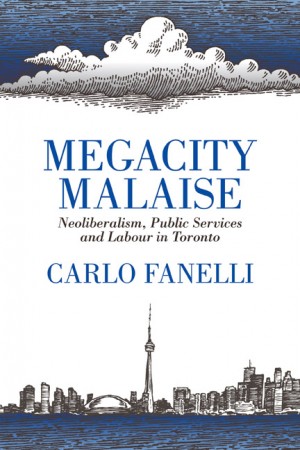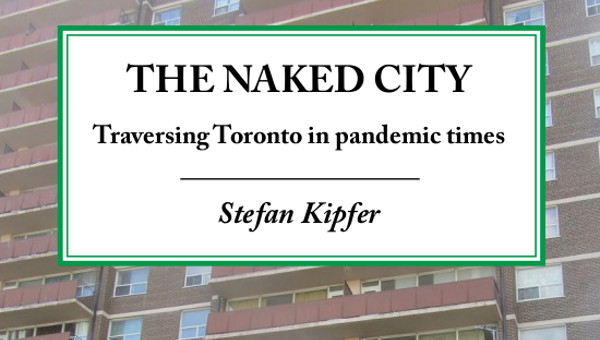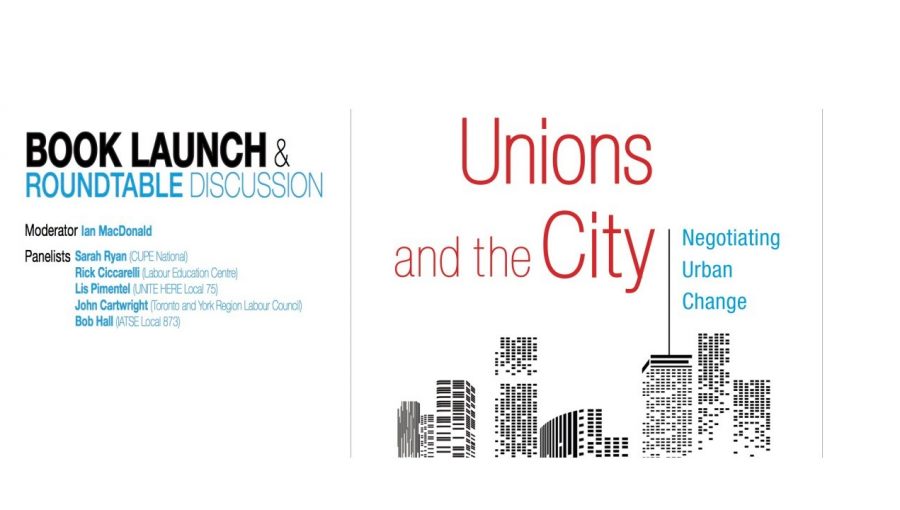Local Roads to Austerity: Neoliberal Urbanism in Canada
The ‘urban question’, as it came to be called in the 1970s, is now a central focus of academic study, state planning and political struggle alike (Castells 1977; Harvey 1973).1 It is impossible to disentangle these concerns with today’s ‘urbanized world’, in all its myriad of social forms, from meta-cities to ex-urban sprawl, and the political economy of capitalist development. With half of the world’s population now living in urban locales, the UN-Habitat’s World Cities Report 2016 offers a glimpse of the world-historical transformations.

The raw figures are, at times, difficult to fathom: over 500 cities of one million; one in three of the world’s population living in slums; the urban conglomeration centred on Tokyo estimated at some 35 million; and meta-cities of 10 million or more becoming something of a commonplace.
If the most mesmerizing urbanization developments today are taking place in the ‘global south’ (with an astonishing variation in settlement patterns and urban forms), North America remains the most urban of the continents with Canada, by some measures, being more urbanized than the United States. The leading urban cores in Canada – Montreal, Toronto and Vancouver – continue to grow demographically, spatially and in density at generous clips. The Greater Toronto Area, Canada’s meta-city, now has a population pushing toward some 7 million, growing steadily at over 100 thousand per year, with its urban armatures stretching hundreds of kilometers in all directions from the shores of Lake Ontario (Table 1).
| Table 1 Canada’s Largest Cities | ||
|---|---|---|
| Geography | Nominal GDP per Capita 2009 |
Population Size 2014 |
| Toronto | 48,532 | 6,055,724 |
| Montreal | 41,718 | 4,027,121 |
| Vancouver | 44,249 | 2,470,289 |
| Calgary | 61,246 | 1,406,721 |
| Edmonton | 59,941 | 1,328,290 |
| Ottawa-Gatineau | 55,506 | 1,318,122 |
| Quebec | 42,940 | 799,632 |
| Winnipeg | 42,522 | 782,640 |
| Hamilton | 37,057 | 765,228 |
| Kitchener-Waterloo | 43,989 | 506,858 |
| London | 41,319 | 502,360 |
| Halifax | 43,471 | 414,398 |
| St. Catharines-Niagara | 33,137 | 405,906 |
| Oshawa | 28,918 | 384,143 |
| Victoria | 46,763 | 358,685 |
| Windsor | 36,194 | 333,937 |
| Saskatoon | 49,213 | 300,634 |
| Regina | 65,404 | 237,758 |
| Sherbrooke | 32,650 | 212,061 |
| St. John’s | 49,844 | 211,724 |
| Barrie | 30,892 | 200,416 |
| Sudbury | 42,138 | 165,690 |
| Guelph | 44,217 | 150,946 |
| Sources: Statistics Canada, CANSIM, Table 381-5000; Table 051-0056; Table 326-0022. Figures based on a census metropolitan area (CMA) formed by one or more adjacent municipalities linked to a population centre (known as the core city). | ||
The territorial demarcation of the urban landscape is, in consequence, thoroughly blurred. The old division of rural-urban (which traditionally dominated both urban studies and Canadian political economy) has lost meaning from the extension of the urban across geographical space alongside the intensification of built space within urban centres. The thesis that capital accumulation produces urban space is, even if a general abstraction, foundational to any adequate understanding of cities. It is, however, still necessary to investigate the particularities of the spatial and temporal forms and patterns of urban political economy today. This initially can be captured in the transition, as David Harvey (1989a) first termed it, from a postwar Keynesian ‘managerial urbanism’ to the ‘neoliberal city’ of the last decades. This is, on the one hand, a particular historically-situated abstraction positing a socio-spatial shift from the ‘national-local’ to the ‘global-national-local’ as capital restructured its patterns of accumulation and reproduction.
On the other, it is a set of specific contentions about the circulation of capital as it traverses and fixes urban space and the remaking of the modalities, apparatuses and capacities of local states. The terms ‘neoliberal urbanism’ and ‘urban austerity’ (the latter term focusing on the mutation of the 2008 financial crisis into new urban policy mandates) identify the production of particular built environments and urban planning practices. This does not mean – as neoliberal rhetoric suggests – a withdrawal of the state from the ‘market’ and the urban political economy. Rather, the terms signal the need to investigate the specific forms of neoliberal urbanism in Canada; and the individual ways the apparatuses of each local state has been subjected to the fiscal disciplines of austerity.
Urbanism and Capital Accumulation
The dynamics of capital accumulation directly shape the built and natural environments of the urban political economy. The growing organizational complexity of capital depends, in turn, upon a parallel process of ‘statification’. As the fixed capital required for factories and offices becomes increasingly intricate, and the technical labour required to staff these facilities also grows, government support for infrastructure, research and development, technical training, financing and regulatory intervention becomes necessary. Government revenues and resources become progressively more mobilized in the interest of accumulating capital for the owners and senior executives of corporations. This is the idea that the accumulation of capital is the production of space as a built environment: capitalism is always urbanization.
It is here, in the processes of accumulation, that neoliberal urbanism needs to be situated Brenner and Theodore 2002). Neoliberalism first appeared in the 1970s as a project to break working class resistance to the restructuring of capital and the state. Its economic policy regime can be summarized as ‘market-expanding’ in its regulatory focus on the market determination of distribution and allocation of output, the internationalization of capital, the monetization of the public sector, and self-regulation by market dependence for economic agents. As with any economic policy regime, neoliberalism forms within particular political strategies and is institutionally mediated within states. Neoliberal policy regulation is always, therefore, uneven and differentiated across political jurisdictions and governance scales, or ‘variegated’ in the terminology common to urban geography (Hackworth and Moriah 2006; Peck, Theodore and Brenner 2009b). Neoliberalism thus serves as a prelude to the fiscal retrenchment of cities and the urban, in turn, the terrain in which neoliberal practices are continually being re-invented.
Neoliberal Urbanism in Canada
Neoliberal urbanism in Canada can, in some respects, be dated back to the 1970s with the end of the postwar ‘Fordist’ boom and the political struggles to reorder the matrix of state policies (Fanelli 2016). That more market-oriented policy practices began to break surface on the terrain of the local state in Canada is, in retrospect, not entirely surprising, given the openness to international capital flows and urban development of almost any kind. The federal government abandoned any overseer role in urban development in the 1970s, and housing policy reoriented to increased support for private sector mortgage markets and developers. The provinces also began to push for municipal amalgamations to bring a measure of rationalization to providing services to the sprawling ‘Fordist’ suburbs, from the focus on the car and single-unit dwelling, and to bolster the attractiveness of cities for business investment (Filion and Kramer 2011, 203-07).
Through the 1980s state and industrial restructuring drastically increased the population dependent on welfare. Manufacturing deindustrialization both downsized workplaces and shifted many industrial plants to lower-tax, lower-unionized ‘greenfield’ sites and ex-urban regions. At the same time, financialization led to a huge expansion of the speculative activities and bureaucracies associated with the banking and insurance sectors. With the North American free trade agreements and the increasing inter-penetration of Canadian and U.S. capital, these economic developments intensified, while being steadily replicated across the world market. This led Toronto, Montreal and Vancouver to stake their claim, as argued by Roger Keil and Stefan Kipfer (2003, 335-36), as “world cities” more “transnationalized” than other Canadian cities, with unique “pathways to urbanization”.
In this context, neoliberalism consolidated as the policy framework through the 1990s. Under Prime Minister Brian Mulroney, the federal government began to limit fiscal transfers to the provinces in terms of equalization payments but also the funding of key social programmes. The downloading process accelerated under the Liberals in the mid-1990s with the new Canada Health and Social Transfer withdrawing the federal government from direct funding of many programs as well as reducing overall transfer levels. In turn, provincial governments, freed from federal fiscal constraints and facing increased costs and less revenues, offloaded more programs and funding responsibilities onto the municipalities (Table 2). This included their support to both cities and planning capacities of provincial municipal affairs departments.
| Table 2 Municipal Expenditure Responsibilities, Provinces and Territories, 2008 |
|||||||||||||
|---|---|---|---|---|---|---|---|---|---|---|---|---|---|
| NF | PEI | NS | NB | QC | ON | MB | SK | AB | BC | YU | NWT | NU | |
| General government services1 | x | x | x | x | x | x | x | x | x | x | x | x | x |
| ↳ Protection of persons and property | x | x | x | x | x | x | x | x | x | x | x | x | x |
| ↳ Courts of law | x | x | x | x | x | x | x | x | x | x | x | x | |
| ↳ Policing | x | x | x | x | x | x | x | x | x | x | x | ||
| ↳ Firefighting | x | x | x | x | x | x | x | x | x | x | x | x | x |
| ↳ Regulatory measures | x | x | x | x | x | x | x | x | x | x | x | ||
| Transportation and communication2 | x | x | x | x | x | x | x | x | x | x | x | x | x |
| Public Health | x | x | x | x | x | x | x | x | x | x | x | x | x |
| ↳ Hospital care | x | x | x | x | x | ||||||||
| ↳ Medical care | x | x | x | x | x | ||||||||
| ↳ Preventive care | x | x | x | x | x | x | x | x | x | x | x | x | |
| ↳ Other health services | x | x | x | x | x | x | x | x | x | x | |||
| Social services | x | x | x | x | x | x | x | x | x | x | x | ||
| ↳ Social assistance | x | x | x | x | x | x | |||||||
| ↳ Other social services | x | x | x | x | x | x | x | x | x | x | x | ||
| Education | x | x | x | x | x | x | x | x | |||||
| Resource conservation and industrial development | x | x | x | x | x | x | x | x | x | x | x | x | x |
| ↳ Agriculture | x | x | x | x | x | x | |||||||
| ↳ Other | x | x | x | x | x | x | x | x | x | x | x | x | x |
| Environment3 | x | x | x | x | x | x | x | x | x | x | x | x | x |
| Recreation and culture | x | x | x | x | x | x | x | x | x | x | x | x | x |
| Housing | x | x | x | x | x | x | x | x | x | x | x | x | x |
| Regional planning and development | x | x | x | x | x | x | x | x | x | x | x | x | x |
| * An x denotes per capita expenditure larger than $10. | |||||||||||||
| 1 General government services includes expenditures on executive, legislative, administrative, and other services. | |||||||||||||
| 2 Transportation includes expenditures on roads, snow and ice removal, parking, and public transit. | |||||||||||||
| 3 Environment includes expenditures on water purification, sewage, garbage and waste collection, and disposal, and other services. | |||||||||||||
| Source: Statistics Canada, CANSIM, Table 385-0024; Table 051-0005. | |||||||||||||
The reorganization of multi-level governance became a pre-occupation of the Canadian state to try and re-assign fiscal capacities and policy functions with a neoliberal policy regime oriented to international competitiveness as NAFTA was implemented (Andrew 2003; Donald 2005). The downloading of service provisions and responsibilities from federal and provincial governments to municipalities has been a central neoliberal policy and administrative strategy. It was a means to challenge universal non-market provision of social services, with democratic pressures to advance to higher standards, toward market provided services that are both priced and delivered at lower standards for the average user. This translated into specific policy objectives: the lowering of taxes; the withdrawal of government from providing services and pricing the rest to users as feasible; the lowering of public sector employment; norming public sector wages to lag private sector settlements; and the creation of new profit opportunities for business through privatization contracting-out, and monetization of the local state. Such new policy measures, with their new modes of urban administration, did not merely respond to the new world market configuration. They also shaped a spatial polarization in Canadian cities between inner-city gentrification and professional employment, and outer suburbs of aging residential blocks segmented by race, immigration settlement and precarious service-sector employment (Kipfer and Keil 2002).
As a result of coping with one fiscal crisis after another across the scales of the Canadian state since the 1980s, a vast underfunding of infrastructure exists in Canada, particularly in housing and transit, but extending from urban forestry to social support facilities, In the leading cities, the shortfalls can be dramatic given the increasing demands from a booming population. With finance strapped from transfer cuts, and competitive pressures on the existing property tax base, municipal budgets increasingly depend upon development projects of all kinds to generate charges and to widen the tax base. Provincial states aided this process by deregulating municipal planning controls while leaving regional planning and governance ineffectual. This ‘competitive city’ politics is further promoted, as mapped out by Gene Desfor and his colleagues (2006), by new modes of neoliberal planning – marketization of the local state; discretionary implementation of urban design, zoning and density bylaws; business-dominated urban development corporations; subsidized knowledge industry clusters; and others. These market-expanding policies assist the developer-led boom in the inner-cities in the name of densification and ‘smart growth’, while also encouraging suburban subcentres to concentrate malls and offices and massive new housing tracts pushing against – and often breaching – ‘green belts’ meant to border in development. Smart growth planning across Canada often looks just like more development for the assessment charges are crucial to cover the fiscal distress of municipal budgets.
This fiscal bind has led to many calls for a new urban agenda for Canada. In the early 2000s, then Prime Minister Paul Martin proposed a ‘new deal for cities’. It was hardly visionary. It included some minor sharing of gas tax revenue to support public transport, and recycling commitments to social housing and public infrastructure. The quick ouster of Martin from office let even these modest proposals fall to the side. The Conservatives under Prime Minister Stephen Harper did next to nothing about urban issues, seeing this in strict constitutionalist terms as a matter of provincial jurisdiction. The Conservatives preferred one-off bilateral deals between the federal government and individual cities to support a specific project, such as supports for spectacle architecture projects or world sporting events, or a public transit line here and an urban regeneration project there. In this regard, the Liberal government of Justin Trudeau has largely continued in the footsteps of their Conservative predecessors leaving in place the pattern of ad hoc agreements without any coherent strategy to repair some four decades of urban malaise (Boudreau, Keil, and Young 2009; Young and Horak 2012).
Urban Fractures and Local Lefts
Neoliberal urbanism never takes a singular form, unfolding as a variegated social process, each city becoming its own terrain of experimentation in new modes of administration. A tally of these modes could easily be multiplied: the utter failure to sustain low cost public transit; the vulgar monetization and commodification of public spaces; the lack of any coherent strategy to address the degradation of work conditions and wages for precarious and immigrant workers; the undermining of public planning capacities to control urban sprawl or match densification with adequate infrastructure; and too many others. If capitalism produces urban space integral to its ‘laws of development’, neoliberal urbanism always internalizes the disjunctures and antagonisms between the global accumulation imperatives of capital and the historic ‘life-places’ of workers and their communities.
In Canada, the asymmetries in fiscal capacities across the scales of governance refract into the urban political economy as a constantly shifting constraint on the parameters of local policy-making. In a quite formal way, the essential extra-market functions that cities provide in the building of urban space are always in a position of financial constraint from the fiscal paternalism embedded in Canadian federalism and constitutionalism. There is, in a sense, a state of permanent fiscal crisis in municipal finances in Canada, leaving Canadian localities always to beg for ‘new deals’ – as the Federation of Canadian Municipalities continues to do, under one name or another.
The neoliberal fiscal practice of downloading administrative responsibilities without parallel fiscal capacities to subnational and local states has been a particularly powerful incubator of urban austerity. Indeed, the general adoption of a fiscal regime of austerity across the scales of governance, in response to the continued economic turbulence from the financial crisis of 2008-10, has led to further closure of fiscal space at the local level. Neoliberal urbanism can be expected – as in the areas of employee relations, infrastructure, and housing used as exemplars here – to undergo even more innovation, policing, privatization, monetization and defunding. The fiscal distress of local states in Canada, under the continual pressures of providing for the urbanization of capital accumulation, already is cause to all kinds of political contortions and grotesque social inequalities in an impossible effort to manage this contradiction of capitalist cities.
 Canadian cities have been the stage for any number of campaigns of resistance to neoliberal urbanism – the ‘sanctuary city’ project to protect undocumented workers; the ‘riders’ campaigns for affordable public transit; the ‘Fight for $15’ living wage mobilization (Evans and Fanelli 2016); the ‘union-community’ alliances to protect municipal services from cuts and privatization; the urban ecology movements insisting on cities address climate change by blocking pipeline expansion for transporting fossil fuels from the Tar Sands and the expansion of parks and green spaces; and many others. In municipalities across Canada, there have been a slew of petitions, disruptions of Council proceedings, occupations, demonstrations, community watches of police, neighborhood rallies – a part of the pattern of everyday urban life. But these have largely remained defensive reactions to the latest austerity initiative, and suffering battle fatigue from years of campaigning, with every gain under threat from new round of austerity, and every zone of failure open to right-wing populism (Kipfer and Saberi 2015).
Canadian cities have been the stage for any number of campaigns of resistance to neoliberal urbanism – the ‘sanctuary city’ project to protect undocumented workers; the ‘riders’ campaigns for affordable public transit; the ‘Fight for $15’ living wage mobilization (Evans and Fanelli 2016); the ‘union-community’ alliances to protect municipal services from cuts and privatization; the urban ecology movements insisting on cities address climate change by blocking pipeline expansion for transporting fossil fuels from the Tar Sands and the expansion of parks and green spaces; and many others. In municipalities across Canada, there have been a slew of petitions, disruptions of Council proceedings, occupations, demonstrations, community watches of police, neighborhood rallies – a part of the pattern of everyday urban life. But these have largely remained defensive reactions to the latest austerity initiative, and suffering battle fatigue from years of campaigning, with every gain under threat from new round of austerity, and every zone of failure open to right-wing populism (Kipfer and Saberi 2015).
In Vancouver and Montreal (and to a lesser extent Winnipeg), the Left has historically formed wider political groupings. But these have all been more city-wide electoral pacts than political and campaigning organizations of the Left to develop an alternate agenda for urban space and to contest the capitalist city. In Toronto, the NDP has a quite loose municipal caucus, and it has been years since a socialist presence on city council making the anti-capitalist case and demanding a more radical local democracy has been heard. The local Left has all but dissolved as an active force contesting local centres of power. The last two decades or so of everyday urban politics in Canada has individual councilors attempting to leverage minor social measures out of the latest development scheme and condo complex, negotiating the trimming of municipal services on the least unfavourable terms, and supporting local – preferably green – entrepreneurs and markets. There is nothing in any of this that one can possibly conjure as the means to break with urban austerity.
The Left tradition has historically been quite different. Following from the Paris Commune, workers’ councils and ‘water and sewer socialism’, it has focused on the reorganization, democratization and decentralization of political and economic activity. The ‘urban revolution’ was central, Lefebvre (1991, 54) argued, to any transformative prospects: “A revolution that does not produce a new space has not realized its full potential; indeed it has failed in that it has not changed life itself, but has merely changed ideological superstructures, institutions or political apparatuses.” But this was never seen as a project isolated to single urban centres – a localism ‘in-itself’ as the objective of political resistance. Instead, local bases of power and self-administration had to be integrated into revolutionary projects to transform national state power and to internationalize political struggles and alliances against the world capitalist market (Mayer 2009; Harvey 2012). Any alternate politics in Canada today will have to produce new urban spaces – a right to good work and living wages, of a new infrastructure of free transit and public spaces, of social housing for all. But also more: it will have to be project of ‘rebel cities’ connecting across the networks and scales of the Canadian state.
The urban political economy of Canada raises crucial strategic and political questions. Canadian Political Economy has often had a pre-occupation with the national state, capital and trade flows, and the economic policies that formed Canada’s place in the world market. This has focused much debate (and politics, too) on the degree of autonomy of the Canadian state to form policy alternatives independent of the American empire. The study of urban political economy has established that even as the accumulation of capital breaches scales of political governance to form a world market, this is also – and necessarily so – an urbanization process nested in other scales of political economy. Critical urban studies in Canada has, however, tended to juxtapose the urban to the global, eviscerating the regional and the national in abstract calls for a transnational urbanism of resistance. But even a cursory examination of urban austerity reveals that constituted state powers remain administrative obstacles and political forms that require strategic address not theoretical elision. If a radical politics of localism to challenge neoliberal urbanism is to emerge in Canada, it will do so from multiple cities in a national politics of transformation in its organizational capacities and internationalist in its commitments. New studies in the political economy of Canada, this essay concludes, will be crucial to bridging these divisions of political scale in research focus and activist ambitions in social struggles. •
References:
- Andrew, Caroline. 2003. “Municipal Restructuring, Urban Services and the Potential for the Creation of Transformative Spaces.” In Changing Canada: Political Canada as Transformation, edited by Wallace Clement and Leah Vosko, 311-334. Montreal: McGill-Queen’s University Press.
- Boudreau, Julie-Ann, Roger Keil, and Doug Young. 2009. Changing Toronto: Governing UrbanNeoliberalism. Toronto: University of Toronto Press.
- Brenner, Neil, and Nik Theodore. 2002. “Cities and the Geographies of “Actually ExistingNeoliberalism”.” Antipode 34(3): 341-347.
- Castells, Manuel. 1977. The Urban Question. Cambridge: MIT Press.
- Desfor, Gene, Roger Keil, Stefan Kipfer, and Derda Wekerle. 2006. “From
Surf to Turf: No Limits to Growth in Toronto?” Studies in Political Economy 77:131-155. - Donald, Betsy. 2005. “The Politics of Local Economic Development in Canada’s City-Regions.” Space and Polity 9(3):261-281.
- Evans, B. and C. Fanelli. 2016. The Living Wage Movement in Canada: Prospects and Challenges. Interface: A Journal For and About Social Movements, 8(1), 77 – 96.
- Fanelli, Carlo. 2016. Megacity Malaise: Neoliberalism, Labour and Public Services in Toronto. Halifax, Nova Scotia: Fernwood Publishing.
- Filion, Pierre, and Anna Kramer. 2012. “Metropolitan-Scale Planning in Neoliberal Times.”Space and Polity 15(3): 197-212.
- Hackworth, Jason, and Abigail Moriah. 2006. “Neoliberalism, Contingency and Urban Policy: The Case of Social Housing in Ontario.” International Journal of Urban and Regional Research 30(3): 510-527.
- Harvey, David. 1973. Social Justice and the City. Baltimore: John Hopkins University Press.
- — 1989. “From Managerialism to Entrepreneurialism: The Transformation of Urban Governance in Late Capitalism.” Geografiska Annaler, Series B, Human Geography71(1): 3-17.
- –2012. Rebel Cities. London: Verso.
- Keil, Roger, and Stefan Kipfer. 2003. “The Urban Experience and Globalization.” In Changing Canada: Political Canada as Transformation, edited by Wallace Clement and LeahVosko, 335-362. Montreal: McGill-Queen’s University Press.
- Kipfer, Stefan, and Roger Keil. 2002. “Toronto Inc.? Planning the Competitive City in the New Toronto.” Antipode 34(2): 227-264.
- Kipfer, Stefan, and Parastou Saberi. 2015. “The Times and Spaces of Right Populism: From Paris to Toronto.” In The Socialist Register: The Politics of the Right, edited by Leo Panitch and Greg Albo, 312-332. London: Merlin.
- Lefebvre, Henri. 1991. The Production of Space. Oxford: Blackwell.
- Mayer, Margit. 2009. “The ‘Right to the City’ in the Context of Shifting Mottos of Urban SocialMovements.” City 13: 2: 262-374.
- Peck, Jamie, Nik Theodore, and Neil Brenner. 2009b. “Neoliberal Urbanism: Models, Moments, Mutations.” SAIS Review, 29(1): 49-66.
- Statistics Canada. 2009. “Local General Government Revenue and Expenditures, Current and Capital Accounts, Annual (dollars).” CANSIM, Table 385-0024. www5.statcan.gc.ca
- Statistics Canada. 2015e. “Estimates of Population by Census Metropolitan Area, Sex and Age Group for July 1, based on the Standard Geographical Classification (SGC) 2011, Annual (persons).” CANSIM, Table 051-0056. www5.statcan.gc.ca
- UN-Habitat. 2016. World Cities Report 2016: Urbanization and Development – Emerging Futures. Nairobi: UN-Habitat.
- Young, Robert, and Martin Horak, eds. 2012. Sites of Governance: Multilevel Governance and Policy Making in Canada’s Big Cities. Montreal & Kingston: McGill-Queen’s University Press.
This article first published on the Austerity and its Alternatives website.
Endnotes
- This paper is a revised and condensed version of the forthcoming full-length article by the authors titled “Fiscal Distress and the Local State: Neoliberal Urbanism in Canada.” In Thomas, M., L.F. Vosko, C. Fanelli and O. Lyubchenko, eds. Continuity and Change: Rethinking the New Canadian Political Economy. Montreal and Kingston: McGill-Queens University Press.





